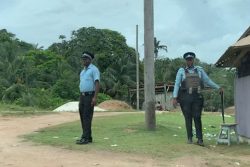The availability of land for housing has allowed many citizens to move from squatting in shacks, overcrowding their parents’ or relatives’ homes or from being homeless to becoming home owners. While for some, this has been fulfilling, for others, it has been arduous and continues to be so.
The People’s Progressive Party administration had prided itself on its housing drive. During the terms of its various leaders, but particularly those of Mr Bharrat Jagdeo and Mr Donald Ramotar, thousands of house lots were distributed to applicants throughout the country. In addition, large swathes of land were sold to private developers to build houses and sell them to citizens. A lot of the land which was converted for housing was reclaimed canefields that the government purchased from the Guyana Sugar Corporation (GuySuCo).
It was the then government’s way of killing two birds with one stone: providing funds to prop up the failing sugar industry, which, with its production contracting, no longer needed so much land, and opening new areas for housing that would hopefully take care of the burgeoning shantytowns that were the population’s response to policies not having caught up with growth.
Did it work? Not so much. GuySuCo, for various reasons that have been endlessly debated in this newspaper and elsewhere, sunk deeper and deeper into the abyss of debt, helped along by poor decisions on expenditure, and regardless of how many billion-dollar bailouts it received from the government every year.
The housing side of it, well in many ways that bird also flew away with its neck intact. It is not that it could not be done. On the contrary, Pradoville 1 at Ogle, East Coast Demerara, is a great example of a housing scheme done right. It was set up with infrastructure such as roads and utilities so that persons building there had no difficulty in doing so. However, it was never meant to accommodate any of the average Joes or Janes who would have been languishing in a squatting area, ramshackle rental or overcrowding their parents’ homes. The residents of Pradoville 1 as is well known, are members of the then PPP government and their friends. A point to note is that the same thing occurred with Pradoville 2.
The majority of the other housing schemes have failed to provide the residents with even a modicum of what should be part of a public housing complex. After paying large sums for their plots of land, many would-be home owners are shocked to discover that the land is all they are getting. There are no proper roads, mediocre drainage, and no water or electricity. Despite all of these failings on the part of the government, owners are expected to quickly get their houses built or face the threat of losing the initial investment they made in the land.
Ideally, how it should work is that the money collected for purchases should be used to develop the land so that when the home owners begin to build there are roads to allow for the trucking in of materials, and water is available as it is necessary. Then by the time the houses are completed and people are ready to move in, the area is already electrified so that residents have lights in their homes and surroundings. Anything less, and all they have done is replace one shantytown for the next, with the exception being that they own the property and have to pay a mortgage on it, plus be responsible for wear and tear caused by flooding and whatever else is wrought to their properties by the poor infrastructure.
The Diamond, Grove and Parfait Harmonie schemes, which the PPP administration took much pride in, have also been plagued for years with poor roads and water problems and to date, years after they were established, many of these issues have not been completely resolved.
In a story published earlier this week, this newspaper reported on other housing schemes at Plantation Providence, EE Eccles, Herstelling, Farm and Covent Garden, all on the East Bank Demerara. The report addressed crime and the police response or lack of it. Told that the police might be unable to respond fully because in many cases streets are unnamed and given their newness they are unfamiliar with the layout of these places, the Housing Authority’s Chief Executive Officer Lelon Saul said that if the police ask, they will receive a copy of the housing plan, or they can use Google Maps. For the record, Mr Saul should be aware that Google Maps is an electronic database, which will not work in areas that do not have street names; in addition to use that technology the police stations will need WiFi or the police officers will have to use the data on their cell phones.
Is this how it is supposed to work? Should the police not be given all the tools necessary to provide service and protection to these communities or are they to remain a mere afterthought in every facet of their development? While the police can certainly drive around on patrols and familiarise themselves with these housing schemes, no one should lose sight of the fact that the force is under strength. And while this possibly can work in areas where streets are laid out east to west and north to south, it can cause confusion where there are curves, bends and cul de sacs or any circuitous roads.
As it stands, postmen and women have difficulty delivering mail in the city where streets are well known and clearly demarcated; what on earth happens in these areas? The relevant authorities must work more swiftly to complete the development of these housing schemes so that people who have invested their life’s savings can live comfortably and others who are awaiting improvements to start building their homes can begin to do so.









